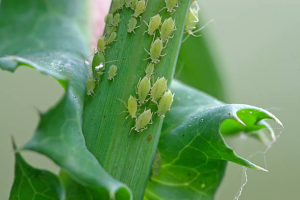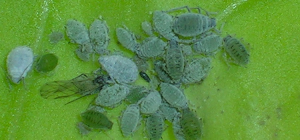

- Aphids are small sap-sucking insects A typical life cycle involves flightless females giving live birth to female nymphs—who may also be already pregnant, an adaptation scientists call telescopic development—without the involvement of males. Maturing rapidly, females breed profusely so that the number of these insects multiplies quickly. You may not notice a few aphids on one day, but within a few days a large colony will have developed. And it doesn’t take long before your entire crop has been ruined.
- Looking at a graph — comparing the growth of aphid populations (exponential growth) to that of other insect pests (arithmetic growth) — shows how they quickly become such a problem:
-
Winged females may develop later in the season, allowing the insects to colonize new plants. A phase of sexual reproduction occurs in the autumn, with the insects often overwintering as eggs.
Identification/Appearance:
- Aphids are green to grey, soft-bodied insects that grow in colonies on plant leaves and stems.


-
Cabbage aphids are more of a wooly, gray-green.


Signs of damage
- Low to moderate numbers of leaf-feeding aphids aren’t usually damaging to plants. However, they do leave a sticky residue, known as honeydew, which nourishes a sooty black mold fungus.
- Whether your leafy greens have a large colony of aphids (most often beginning on the underside of leaves where you don’t notice them right away) or the sooty residue, they’re no longer fit for human consumption. Small colonies of aphids can be rinsed off with a water spray and restore the leaf crop to edible condition. Heavier infestations or leaves stained with sooty mold are probably best just discarded.


Controls
- Since aphids are not very mobile during the growing season, the best control for established colonies is to blast them away with a high pressure spray of water from a garden hose.
- Beneficial insects — most notably lady bugs and lacewings — are natural predators on aphids.
- Insecticidal soaps and Neem oil are not generally recommended controls since they kill not only aphids but also any beneficial insects that may be preying on them. On the other hand, those may have to be used to eradicate a population of aphids that’s become well-established.
Incidentally, if you see ants present along with aphids it suggests that the ants are “farming” the aphids — much as farmers establish herds of dairy cows. In fact, ants will “milk” aphids by stroking them with their antennae in order to stimulate the aphids into producing more honeydew. Yeah, these are amazing insects.
